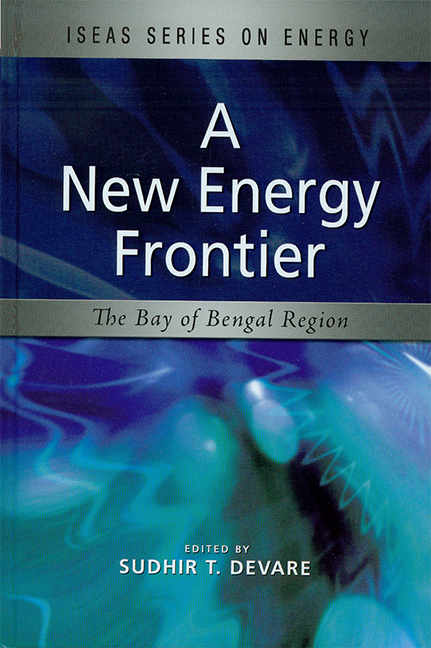Book contents
- Frontmatter
- Content
- Foreword
- Message from the Director
- Preface
- The Contributors
- 1 An Overview of the Energy Scene in the Bay of Bengal Region
- 2 Current and Expected Energy Production and Consumption within the Bay of Bengal Region: A Synopsis
- 3 Gas Potential at the Bay of Bengal and Implications for India's Energy Security
- 4 Macroeconomic Challenges for the Growth of the Energy Sector in Bangladesh in the Context of Regional Integration
- 5 Energy in the Bay of Bengal Region: Myanmar's Perspective
- 6 Marine-related Energy Resources in the Eastern Indian Ocean: Indonesian Perspective
- 7 Energy Trading and Singapore's Role as a Hub
- 8 Bay of Bengal: Awakening of a Potential Giant Area
- 9 Energy Transportation Security in the Bay of Bengal
- 10 Ethical Business Practice or Camouflage? Energy and Mining Companies and Corporate Social Responsibility
- 11 Sustainable and Renewable Energy: Scenarios for the Future
- Index
8 - Bay of Bengal: Awakening of a Potential Giant Area
Published online by Cambridge University Press: 21 October 2015
- Frontmatter
- Content
- Foreword
- Message from the Director
- Preface
- The Contributors
- 1 An Overview of the Energy Scene in the Bay of Bengal Region
- 2 Current and Expected Energy Production and Consumption within the Bay of Bengal Region: A Synopsis
- 3 Gas Potential at the Bay of Bengal and Implications for India's Energy Security
- 4 Macroeconomic Challenges for the Growth of the Energy Sector in Bangladesh in the Context of Regional Integration
- 5 Energy in the Bay of Bengal Region: Myanmar's Perspective
- 6 Marine-related Energy Resources in the Eastern Indian Ocean: Indonesian Perspective
- 7 Energy Trading and Singapore's Role as a Hub
- 8 Bay of Bengal: Awakening of a Potential Giant Area
- 9 Energy Transportation Security in the Bay of Bengal
- 10 Ethical Business Practice or Camouflage? Energy and Mining Companies and Corporate Social Responsibility
- 11 Sustainable and Renewable Energy: Scenarios for the Future
- Index
Summary
INTRODUCTION
For the last few years the Bay of Bengal region has come under focus for reasons of energy, trading, security and regional cooperation in general among the countries around the rim of the Bay.
The conference on the subject of “Energy in Bay of Bengal Region” held at the Institute of Southeast Asian Studies on 28–29 September 2006 was therefore an important milestone in that direction which needs to be carried forward.
This issue is addressed in its global perspective since there are many issues that link and affect the various countries of the region in multiple ways. Therefore any discussion on energy must be viewed as part of the overall picture.
The Bay of Bengal region comprises an area of more than 2.2 million square kilometres and 3.0 million, if we add the Andaman Sea and the Malacca Straits. It borders Sri Lanka, India, Bangladesh, Myanmar, Thailand, Malaysia, Singapore and Indonesia. In addition, if we were to also include the land-locked Bhutan and Nepal for whom the nearest sea exit is the Bay of Bengal, then the area and the issues involved become even more important.
Common Heritage
The area has historically been bound together for thousands of years for various reasons given the physical proximity in the first instance. It is a little known fact that Pu Breush Island in Sumatra is only 90 nautical miles or 170 kilometres or Phuket, Thailand is only 275 nautical miles both from Indira Point in Andamans and Nicobars, India. India alone shares maritime boundaries with Sri Lanka, Bangladesh, Myanmar, Thailand and Indonesia.
Not so long ago, Sanskrit was the common and dominant language in the region and the Hindu thought and later Buddhist philosophy created a common cultural thread among all the countries. Indeed, even the spread of Islam in certain countries of the area was from India. Extensive and well established trade between the countries of the region is well documented. Travelling across all these countries, from India to Indonesia, a common heritage is clearly inbuilt even though today each country has its own interests and agenda.
Given these historical ties, the question therefore arises where the region is today.
- Type
- Chapter
- Information
- A New Energy FrontierThe Bay of Bengal Region, pp. 139 - 147Publisher: ISEAS–Yusof Ishak InstitutePrint publication year: 2008



